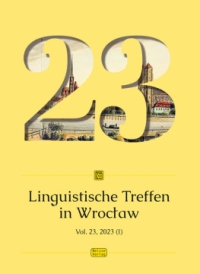Routiniertes Sprachverhalten an der deutsch-polnischen Grenze aus diachroner Perspektive (Beispiele für Redemuster in Deutsch)
Conventionalised Patterns of Language Behaviour at the Polish-German Border Crossing, from a Diachronic Perspective (incl. Examples of Speech Formulae in German)
Author(s): Renata NadobnikSubject(s): Language and Literature Studies, Theoretical Linguistics, Applied Linguistics
Published by: Oficyna Wydawnicza ATUT – Wrocławskie Wydawnictwo Oświatowe
Keywords: conventionalised linguistic formulae; border; diachronic study
Summary/Abstract: The paper deals with conventionalised linguistic formulae that once were or still are in use in communication when crossing the German-Polish border. The research material for this analysis comes from selected German-Polish phrasebooks, from the first printings in the 16th century to recently published editions. Numerous examples of German expressions regarding the specified area are excerpted from the contents of the above-mentioned reference works, then grouped thematically and presented chronologically, sometimes with brief commentary. The aim here is to present expressions used repetitively in language interaction between travelers and customs officials at border control points retrospectively. In addition, reference is made to the (im)politeness and emotional charge of the language used at the border. The analysis carried out showed that the language formulae used at border control points have not changed much over the course of time, starting from the 19th century. Furthermore, it was determined that the communication between customs officials and travelers in the 19th century and at the beginning of the 20th century relied on a large number of conventionalized politeness formulae. In the more recent examples, the language used is also polite, though the formulaic expressions are different as the manner of linguistic politeness itself has changed over the years. In addition, it was possible to find out which regulations applied at the German-Polish border. The present study thus represents a contribution to sociopragmatics while also addressing phraseological issues from a diachronic perspective.
Journal: Linguistische Treffen in Wrocław
- Issue Year: 23/2023
- Issue No: 1
- Page Range: 113-134
- Page Count: 22
- Language: German

